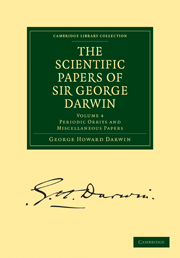Book contents
- Frontmatter
- PREFACE
- Contents
- Chronological List of Papers with References to the Volumes in which they are contained
- Errata
- PART I PERIODIC ORBITS
- PART II THE TIDES
- PART III MISCELLANEOUS PAPERS IN CHRONOLOGICAL ORDER
- 5 On some Proposed Forms of Slide-rule
- 6 An Application of Peaucellier's Cell
- 7 The Mechanical Description of Equipotential Lines
- 8 On a Mechanical Representation of the Second Elliptic Integral
- 9 On Maps of the World
- 10 A Geometrical Puzzle
- 11 A Geometrical Illustration of the Potential of a Distant Centre of Force
- 12 On Graphical Interpolation and Integration
- 13 On a Theorem in Spherical Harmonic Analysis
- 14 On Fallible Measures of Variable Quantities, and on the Treatment of Meteorological Observations
- 15 On the Horizontal Thrust of a Mass of Sand
- 16 On the Formation of Ripple-mark in Sand
- 17 Note on Mr Davison's Paper on the Straining of the Earth's Crust in Cooling
- 18 On the Mechanical Conditions of a Swarm of Meteorites, and on Theories of Cosmogony
- 19 On the Perturbation of a Comet in the Neighbourhood of a Planet
- 20 The Eulerian Nutation of the Earth's Axis
- 21 The Analogy between Lesage's Theory of Gravitation and the Repulsion of Light
- PART IV PAPERS ON TIDES (Supplementary to Volume I)
- PART V ADDRESSES TO SOCIETIES
- APPENDIX
- INDEX
- Plate section
17 - Note on Mr Davison's Paper on the Straining of the Earth's Crust in Cooling
Published online by Cambridge University Press: 07 September 2010
- Frontmatter
- PREFACE
- Contents
- Chronological List of Papers with References to the Volumes in which they are contained
- Errata
- PART I PERIODIC ORBITS
- PART II THE TIDES
- PART III MISCELLANEOUS PAPERS IN CHRONOLOGICAL ORDER
- 5 On some Proposed Forms of Slide-rule
- 6 An Application of Peaucellier's Cell
- 7 The Mechanical Description of Equipotential Lines
- 8 On a Mechanical Representation of the Second Elliptic Integral
- 9 On Maps of the World
- 10 A Geometrical Puzzle
- 11 A Geometrical Illustration of the Potential of a Distant Centre of Force
- 12 On Graphical Interpolation and Integration
- 13 On a Theorem in Spherical Harmonic Analysis
- 14 On Fallible Measures of Variable Quantities, and on the Treatment of Meteorological Observations
- 15 On the Horizontal Thrust of a Mass of Sand
- 16 On the Formation of Ripple-mark in Sand
- 17 Note on Mr Davison's Paper on the Straining of the Earth's Crust in Cooling
- 18 On the Mechanical Conditions of a Swarm of Meteorites, and on Theories of Cosmogony
- 19 On the Perturbation of a Comet in the Neighbourhood of a Planet
- 20 The Eulerian Nutation of the Earth's Axis
- 21 The Analogy between Lesage's Theory of Gravitation and the Repulsion of Light
- PART IV PAPERS ON TIDES (Supplementary to Volume I)
- PART V ADDRESSES TO SOCIETIES
- APPENDIX
- INDEX
- Plate section
Summary
Mr Davison's interesting paper was, he says, suggested by a letter of mine published in Nature on February 6, 1879. In that letter it is pointed out that the stratum of the Earth where the rate of cooling is most rapid lies some miles below the Earth's surface. Commenting on this, I wrote:—
“The Rev. O. Fisher very justly remarks that the more rapid contraction of the internal than the external strata would cause a wrinkling of the surface, although he does not admit that this can be the sole cause of geological distortion. The fact that the region of maximum rate of cooling is so near to the surface recalls the interesting series of experiments recently made by M. Favre (Nature, Vol. XIX., p. 108), where all the phenomena of geological contortion were reproduced in a layer of clay placed on a stretched india-rubber membrane, which was afterwards allowed to contract. Does it not seem possible that Mr Fisher may have under-estimated the contractibility of rock in cooling, and that this is the sole cause of geological contortion?”
Mr Davison works out the suggestion, and gives precision to the general idea contained in the letter. He shows, however, that there is a layer of zero strain in the Earth's surface, and that this layer, instead of that of greatest cooling, must be taken to represent Favre's elastic membrane.
- Type
- Chapter
- Information
- The Scientific Papers of Sir George DarwinPeriodic Orbits and Miscellaneous Papers, pp. 354 - 361Publisher: Cambridge University PressPrint publication year: 2009First published in: 1911

